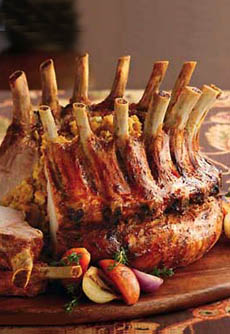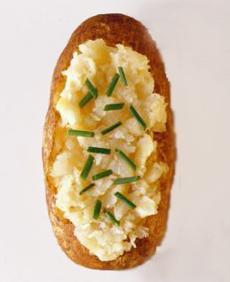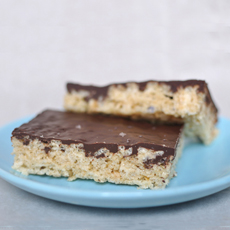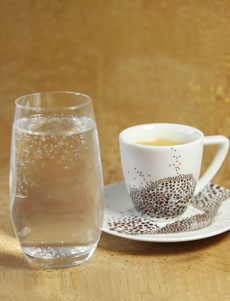
The frenched loin of pork. Photo courtesy
AllenBros.com. |
|
Ingredients For The Potatoes
16 – 20 fingerling potatoes or other small creamer potatoes
¼ cup olive oil
1 tablespoon butter, melted
10 whole garlic cloves in their skins gently smashed
½ teaspoon chopped fresh rosemary
Salt and pepper to taste
Ingredients To Finish The Dish
1 container demi-glace* (or homemade)
1 cup raisins
1 jalapeño, seeds and spines removed (unless you want the heat), thinly sliced
Red wine to deglaze pan
Chopped fresh parsley for garnish
*Demi glaze is a reduced, intense stock reduction made of veal, red wine and shallots. Most high end grocery stores and butcher shops sell frozen veal demi glace. We use the More Than Gourmet brand, but any brand will work.
|
|
Preparation
1. MAKE GINGERED FIGS. Place ginger, allspice berries and black pepper corns in a sachet. Combine with the honey, sugar, water, lime and lemon juices in a heavy, nonreactive pot (see discussion below about reactive vs. nonreactive cookware). Bring to a gentle boil and simmer until the liquid begins to become syrup-like; do not over-reduce. Prep the figs by placing a skin deep “X” on the flower end. Place the figs in a steel pan submerged halfway in ice with some water. Pour the hot liquid over the figs. Refrigerate for up to 10 days.
2. THE NIGHT BEFORE the dinner, combine garlic, lavender, rosemary, thyme, olive oil and mustard. Marinate the pork in this mixture overnight. The following day…
3. BLANCH the potatoes in salted water until creamy in center, cool and cut in half. Toss the potatoes with the olive oil, garlic cloves in their skins, chopped rosemary and melted butter. Season to taste with salt and pepper. Reserve.
4. PREHEAT the oven to 375°F. In a skillet, heat the olive oil and sear the pork over medium high heat. Remove to roasting pan and place in oven. After 20 minutes, add the potatoes cut side down with the garlic cloves and herbs. Allow to roast for 20 more minutes or until internal temperature of pork reaches 140°F. Remove from oven. Remove roast from pan and allow to rest on cutting board at room temperature, covered with a clean kitchen towel.
5. REMOVE excess fat from the pan and sauté the jalapeños on the stove top in the roasting pan, over medium heat for 2 minutes. Add the red wine to deglaze pan. Reduce wine until nearly dry. Add raisins, cut figs in half and add them. Simmer for 5 minutes then gently whisk in butter so as not to damage the figs. Adjust salt and pepper.
6. TO SERVE: Spoon potatoes onto a large platter; slice the chops at each bone and place on top of potatoes. Spoon the figs, raisins and sauce over the entirety. Sprinkle with freshly chopped parsley.
REACTIVE VERSUS NON-REACTIVE POTS & PANS
Reactive cookware—pots and pans—are made of metals that can react with acidic foods (tomato sauce, for example), creating metallic flavors and the discoloration of lighter foods. Non-reactive cookware doesn’t do this, but it typically doesn’t conduct heat as quickly or uniformly (reactive aluminum is second only to reactive copper in ability to conduct heat).
The most ubiquitous cookware, stainless steel, is nonreactive but does not conduct or retain heat well. Good stainless cookware has aluminum or copper bonded to the bottom (or sandwiched in-between stainless layers) to combine the non-reactive surface with rapid, uniform heat conductivity.
Non Reactive Cookware. When a recipe calls for a non-reactive cookware, use ceramic, enameled cast iron or steel, glass, stainless steel or stoneware.
Reactive Cookware. Aluminum, cast iron, copper and steel that is not stainless are reactive metals. However, some cooks find that well-seasoned pans made of these metals do well for short cooking periods.
|






